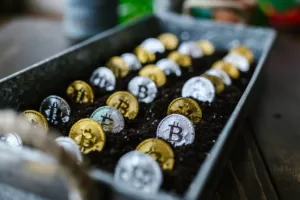Introduction
In an era marked by economic uncertainties and currency fluctuations, investors are increasingly seeking alternative avenues to safeguard their wealth. Precious metals and cryptocurrencies have emerged as attractive options, providing a hedge against the volatility inherent in traditional fiat currencies. This blog explores the dynamics of investing in precious metals and cryptocurrencies, dissecting their potential as effective tools to mitigate the risks associated with currency fluctuations. Before you plan any investment, you must carry out independent research and must consult your finance advisors.
The Historical Significance of Precious Metals

Throughout human history, precious metals such as gold and silver have been revered for their intrinsic value and role as a store of wealth. Gold, in particular, has stood the test of time, serving as a reliable hedge against inflation and economic turmoil. Investors have traditionally turned to gold during times of crisis, viewing it as a safe haven asset that retains value when fiat currencies falter.
The allure of precious metals lies in their tangible nature and limited supply. Unlike fiat currencies, which can be printed endlessly, gold and silver are finite resources, making them resilient to inflationary pressures. This inherent scarcity contributes to their ability to maintain value over the long term.
In the face of currency volatility, precious metals act as a stabilizing force in investment portfolios. They offer a form of diversification that can shield investors from the adverse effects of economic downturns, geopolitical tensions, and fluctuations in traditional currency values. The best thing about the gold is that it dictates the wealth of any country and allow them to print fiat currency equivalent to the worth of gold they hold.
Cryptocurrencies

In recent years, a new player has entered the arena of alternative investments – cryptocurrencies or digital currencies. Led by the pioneering blockchain technology, digital assets like Bitcoin and Ethereum have gained prominence as decentralized, border less forms of currency.
Cryptocurrencies offer a different set of advantages compared to precious metals. Their digital nature provides unparalleled accessibility and ease of transfer across borders, making them a viable option for investors seeking a truly global store of value. The decentralized nature of cryptocurrencies also appeals to those looking to diversify away from traditional financial systems. So far it’s not accepted or recognised internationally and gets hard for the traders to deal internationally. Some of the countries are still reluctant to allow its trade within their financial system and their nationals are deprived of any investment.
Bitcoin, often referred to as “digital gold,” shares some similarities with precious metals in its role as a store of value. Its capped supply of 21 million coins mirrors the scarcity principle of precious metals, contributing to its potential as a hedge against inflation and currency devaluation.
Navigating Currency Volatility with Precious Metals
Investors looking to navigate currency volatility through precious metals should consider the following strategies and must carry out research before doing any investment:
- Diversification: Integrate a proportion of precious metals such as gold and silver into a well-balanced investment portfolio. Diversification helps spread risk and ensures that the overall portfolio is less susceptible to the impact of currency fluctuations.
- Long-Term Perspective: Precious metals are often viewed as long-term investments. Their value may experience short-term fluctuations, but historical data suggests that over extended periods, they tend to appreciate, especially during times of economic uncertainty.
- Safe Haven Allocation: Allocate a specific portion of the investment portfolio to precious metals during times of heightened volatility or crisis. Gold, in particular, has a track record of performing well when traditional markets face turbulence.
Cryptocurrencies: A Modern Approach to Hedging
For those considering cryptocurrencies as a hedge against currency volatility, the following strategies may prove beneficial:
- Educate Yourself: Cryptocurrencies operate in a unique ecosystem, and understanding the fundamentals of blockchain technology and individual digital assets is crucial. Educate yourself on the risks and potential rewards before diving into the world of cryptocurrency investments.
- Dollar-Cost Averaging: Given the inherent volatility of cryptocurrencies, consider implementing a dollar-cost averaging strategy. This involves regularly investing a fixed amount, regardless of the asset’s price at any given moment. This approach helps mitigate the impact of short-term price fluctuations.
- Security Measures: Cryptocurrencies require a secure storage solution. Utilize hardware wallets or reputable cryptocurrency exchanges with robust security measures to safeguard your digital assets from potential threats.
Comparing Precious Metals and Cryptocurrencies
While both precious metals and cryptocurrencies offer unique benefits as hedges against currency volatility, they also present distinct challenges and considerations.
- Volatility: Cryptocurrencies, especially in their early stages, are notorious for their price volatility. While this volatility can present lucrative trading opportunities, it also poses a higher risk for investors compared to the relatively stable price movements of precious metals.
- Tangibility: Precious metals have the advantage of tangibility – investors physically own the metal. Cryptocurrencies, on the other hand, exist purely in a digital form, relying on secure storage solutions to protect against hacking and other cyber threats.
- Market Maturity: Precious metals have a long-established history as a store of value, while cryptocurrencies are relatively new to the financial landscape. The latter’s market is still evolving, subject to regulatory developments and technological advancements.
- Global Acceptance: Precious metals, particularly gold, have been universally accepted as a form of currency for centuries. Cryptocurrencies are still gaining acceptance, and their regulatory status varies widely across different countries. Gold is suggested for long term investment, whereas cryptocurrencies are not long term investments. The amount of investment and affordability of loss would also be another major factor to dictate us the best investment commodity.
Conclusion
Investing in precious metals or cryptocurrencies as a hedge against currency volatility requires a thoughtful and well-informed approach. Both asset classes have their merits and drawbacks, and the choice between them depends on individual preferences, risk tolerance, and investment goals.
For a traditionalist seeking stability and a proven track record, precious metals may offer a reliable refuge. On the other hand, those embracing innovation and the potential for substantial returns might find cryptocurrencies to be a compelling addition to their investment strategy.
In a world marked by economic uncertainties, a balanced and diversified approach that incorporates elements of both precious metals and cryptocurrencies could prove to be a resilient strategy. Ultimately, the key lies in understanding the unique characteristics of each asset class and aligning them with one’s financial objectives in the face of currency volatility. Good luck!
You may like to read: The Future of Currencies in a Turbulent Political Landscape





0 Comments